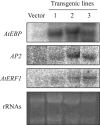Mutual regulation of Arabidopsis thaliana ethylene-responsive element binding protein and a plant floral homeotic gene, APETALA2
- PMID: 17204538
- PMCID: PMC2803001
- DOI: 10.1093/aob/mcl265
Mutual regulation of Arabidopsis thaliana ethylene-responsive element binding protein and a plant floral homeotic gene, APETALA2
Abstract
Background and aims: It has previously been shown that Arabidopsis thaliana ethylene-responsive element binding protein (AtEBP) contributed to resistance to abiotic stresses. Interestingly, it has also been reported that expression of ethylene-responsive factor (ERF) genes including AtEBP were regulated by the activity of APETALA2 (AP2), a floral homeotic factor. AP2 is known to regulate expression of several floral-specific homeotic genes such as AGAMOUS. The aim of this study was to clarify the relationship between AP2 and AtEBP in gene expression.
Methods: Northern blot analysis was performed on ap2 mutants, ethylene-related Arabidopsis mutants and transgenic Arabidopsis plants over-expressing AtEBP, and a T-DNA insertional mutant of AtEBP. Phenotypic analysis of these plants was performed.
Key results: Expression levels of ERF genes such as AtEBP and AtERF1 were increased in ap2 mutants. Over-expression of AtEBP caused upregulation of AP2 expression in leaves. AP2 expression was suppressed by the null-function of ethylene-insensitive2 (EIN2), although AP2 expression was not affected by ethylene treatment. Loss of AtEBP function slightly reduced the average number of stamens.
Conclusions: AP2 and AtEBP are mutually regulated in terms of gene expression. AP2 expression was affected by EIN2 but was not regulated by ethylene treatment.
Figures







Similar articles
-
Redundant enhancers mediate transcriptional repression of AGAMOUS by APETALA2.Dev Biol. 1999 Dec 1;216(1):260-4. doi: 10.1006/dbio.1999.9504. Dev Biol. 1999. PMID: 10588876
-
Ethylene- and pathogen-inducible Arabidopsis acyl-CoA-binding protein 4 interacts with an ethylene-responsive element binding protein.J Exp Bot. 2008;59(14):3997-4006. doi: 10.1093/jxb/ern241. Epub 2008 Oct 3. J Exp Bot. 2008. PMID: 18836139 Free PMC article.
-
Direct regulation of the floral homeotic APETALA1 gene by APETALA3 and PISTILLATA in Arabidopsis.Plant J. 2006 May;46(4):593-600. doi: 10.1111/j.1365-313X.2006.02720.x. Plant J. 2006. PMID: 16640596
-
CYTOKININ RESPONSE FACTORs Gating Environmental Signals and Hormones.Trends Plant Sci. 2016 Dec;21(12):993-996. doi: 10.1016/j.tplants.2016.10.004. Epub 2016 Oct 20. Trends Plant Sci. 2016. PMID: 27773669 Review.
-
Homing into the origin of the AP2 DNA binding domain.Trends Plant Sci. 2005 Feb;10(2):54-6. doi: 10.1016/j.tplants.2004.12.007. Trends Plant Sci. 2005. PMID: 15708341 Review.
Cited by
-
Large-scale identification of gibberellin-related transcription factors defines group VII ETHYLENE RESPONSE FACTORS as functional DELLA partners.Plant Physiol. 2014 Oct;166(2):1022-32. doi: 10.1104/pp.114.244723. Epub 2014 Aug 12. Plant Physiol. 2014. PMID: 25118255 Free PMC article.
-
Nitric oxide sensing in plants is mediated by proteolytic control of group VII ERF transcription factors.Mol Cell. 2014 Feb 6;53(3):369-79. doi: 10.1016/j.molcel.2013.12.020. Epub 2014 Jan 23. Mol Cell. 2014. PMID: 24462115 Free PMC article.
-
A Model for the Gene Regulatory Network Along the Arabidopsis Fruit Medio-Lateral Axis: Rewiring the Pod Shatter Process.Plants (Basel). 2024 Oct 18;13(20):2927. doi: 10.3390/plants13202927. Plants (Basel). 2024. PMID: 39458874 Free PMC article.
-
Key players of singlet oxygen-induced cell death in plants.Front Plant Sci. 2015 Feb 4;6:39. doi: 10.3389/fpls.2015.00039. eCollection 2015. Front Plant Sci. 2015. PMID: 25699067 Free PMC article. Review.
-
Integration of DNA Methylation and Transcriptome Data Improves Complex Trait Prediction in Hordeum vulgare.Plants (Basel). 2022 Aug 24;11(17):2190. doi: 10.3390/plants11172190. Plants (Basel). 2022. PMID: 36079572 Free PMC article.
References
-
- Alonso JM, Hirayama T, Roman G, Nourizadeh S, Ecker JR. EIN2, a bifunctional transducer of ethylene and stress responses in Arabidopsis. Science. 1999;284:2148–2152. - PubMed
-
- Bomblies K, Dagenais N, Weigel D. Redundant enhancers mediate transcriptional repression of AGAMOUS by APETALA2. Developmental Biology. 1999;216:260–264. - PubMed
Publication types
MeSH terms
Substances
LinkOut - more resources
Full Text Sources
Molecular Biology Databases
Research Materials

